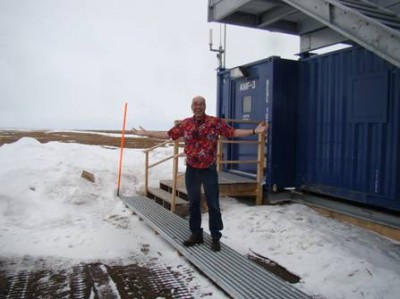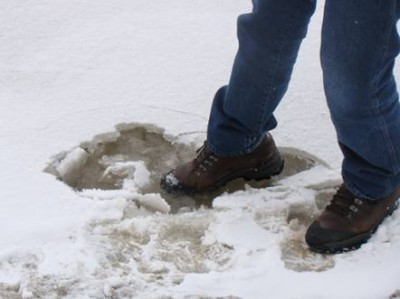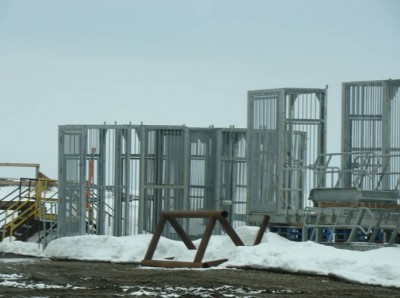On the Amazon: A Very Cold Detour
Published: 11 June 2014
Editor’s note: Stephen R. Springston, a scientist at Brookhaven National Laboratory and an instrument mentor for ARM’s Aerosol Observing System, sent this update.
I knew I had to return to the Amazon, I packed my Hawaiian shirt for a tropical locale. I was thinking about exotic diets, but turns out I was highly unprepared! As you can see in the picture, I reluctantly braved the hardships necessitated by the extreme environment when I arrived at Oliktok Point, Alaska, instead. It blew snow yesterday!

Originally, this trip was planned for Albuquerque to view a candidate structure for this Arctic deployment. That structure was at Sandia National Laboratories, near Albuquerque. However, my host and I decided that it would be better to review the site and see an identical structure in person, here in the Arctic. I write to you at 2:30 a.m. local time and it is light enough outside to read a newspaper. I confessed to a tourist’s enthusiasm and simply had to walk out on the Arctic Ocean (just a stone throw from the site) and dip my toe in.
I’m here at 70.5 degrees north latitude. For comparison, Manacapuru is at 2 degrees south latitude. The contrast shows the breadth of the ARM measurement network. Brookhaven National Laboratory will be building a fourth Aerosol Observing System (AOS) in the next 12 months that will make in situ measurements of aerosols well above the Arctic Circle.

The Oliktok measurement site is in the middle of the Conoco Phillips production fields. We are in sight of a 5 megawatt power station running a desalinization plant for water injection. Other enclaves of oil drilling and production dot the horizon and beyond. Our new AOS will be in a complex of other seatainers separated from these enclaves. The new seatainers were designed and built by a different organization than the original AOS seatainers I’ve mentioned before. They are better insulated and larger inside, but many of the engineering solutions that were worked out before will have to be rejiggered. Much like other ARM sites, instruments will make radiometric (sunlight) and remote radar (cloud and aerosol) measurements of the atmosphere.
Remember the large stack for sucking in aerosols, the one the bees liked in the Amazon? That same tower in the Arctic casts a shadow, but not just to the north, east and west. It can also cast a shadow directly to the south. For that reason, this AOS can’t be near the seatainer with the radiometric instruments or else it would shade them occasionally. Because of the site configuration, it may put it adjacent to a trailer with the diesel turbines for power generation at the site. It will be interesting to see how that goes.

One last note before I get going this morning. Polar bears. I haven’t seen one yet, but they take them quite seriously here. I had to watch a 20-minute video on bear safety. It was actually one of the better safety training videos (or maybe it was just the subject) I’ve endured. Afterwards, on the short jaunt from the housing structure to the site, we rounded a warehousing area and saw these.
These are not cells for atmospheric scientists who have gone crazy, but bear cages for front entrance ways. You do not just come out the door absorbed in thought and get surprised by a hungry bruin with a taste for science; you exit into the cage and look around before placing yourself at #2 in the food chain. One of the big discussions I had (kid you not) was replacing of the new-style lever doorknobs with older-style round knobs that the bears couldn’t open.
The ARM Climate Research Facility is a DOE Office of Science user facility. The ARM Facility is operated by nine DOE national laboratories, including .
Keep up with the Atmospheric Observer
Updates on ARM news, events, and opportunities delivered to your inbox
ARM User Profile
ARM welcomes users from all institutions and nations. A free ARM user account is needed to access ARM data.


















